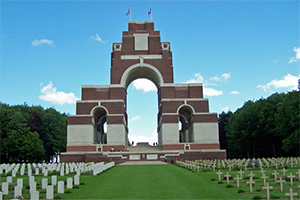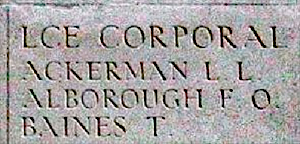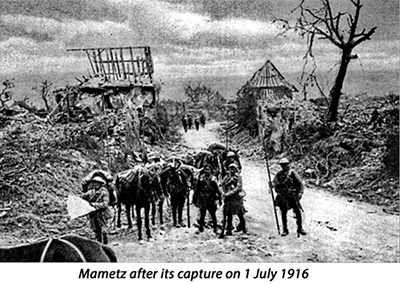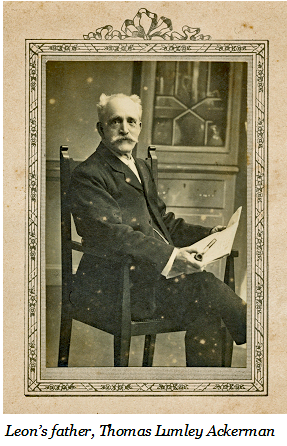First World War Project
Leon Lorden Ackerman (of Lynsted)
b. October 1884 Lance Corporal, Service Number G/5053 |


Leon was born in 1884 and christened in Lynsted Church on 26 October. He was the son of the Headmaster of Lynsted Board School, Thomas Lumley Ackermann, and schoolmistress Annie Collinson Ackermann (née Lorden). Leon was raised in the School House, now the offices of Lynsted and Norton Primary School, where he lived with his two older brothers, Thomas Lorden and Sydney Lorden, and his younger sister Annie Lorden Grace.
Leon's mother died in 1910. At the time of the 1911 Census, Leon was listed as an "unemployed" architect and scrivener. Due to several years of bad health, Leon had left his job as an architect and draughtsman in the Rochester offices of Messrs Drake and Boucher. He was still living in the School House along with his father, sister, and brother Sydney, who was now married to Florence, a native of Tipperary, and working as an accountant in the War Office. Also in residence was domestic servant, Lynsted-born Minnie Bootes, a 22 year old widow.
During December 1914, having only just recovered from his 4 years of illness, Leon enlisted in the army in Sittingbourne 'For the Duration of the War'. He was attached to the 7th (Service) Battalion, The Buffs (East Kent Regiment). The Battalion had been formed at Canterbury in September 1914 as part of the Second New Army (K2) then moved to Purfleet where they joined the 55th Brigade of the 18th Division. After first training at Colchester and then Salisbury Plain, he was posted to France, landing at Boulogne on 28 July 1915. During August 1915, Leon saw his first action at Carnoy, then Fricourt and La Boisselle. Companies took turns in occupying the trenches for an average of 8 days. Thus his battalion was gradually introduced to life in the front-line trenches.
In the spring of 1916, the Battalion was in billets at Picquigny, from where it undertook strenuous training in preparation for the Battle of the Somme. This included a full "dress rehearsal" for the Brigade including aeroplanes and flares. On 10 June, training ceased and the Battalion began making its way to the front line.
On 30 June, at 5.30pm, the Battalion moved from its billets in Bray to the assembly trenches in La Pree Wood (now called Bois St Cauchy). Hot tea with rum was prepared for the men in Carnoy Valley. By midnight the men were in position in their respective assembly trenches.
Poignantly, 1 July 1916 dawned a bright and sunny summer's day. At 7am Leon left the wood to take up position on the front line ready for zero hour of 7.30am.
The following report by Captain A G Kenchington of "B" Company, 7th Battalion, The Buffs, on the operations on 1 July 1916 details the events of the day:
Before "Y" day I had collected and stored in No.10 sap necessary bombs and apparatus. I had put notice-boards directing runners to this point at the end of all saps and trenches in the crater area.
At Zero the three sections of each platoon advanced as arranged round the flanks and the other two sections with snipers went over the craters which were very muddy. The left hand party entered the enemy trenches with only one casualty, the platoon Commander Lieut E.H.A. GOSS, who was killed instantly by a shell. This platoon found the rear portion of the crater area quite knocked out of recognition, and soon overcame two bombing parties and three or four snipers who opposed them.By 8.15 a.m. this party had reported clear and were directed to work across to the help of the other platoon who had sent no news.
The R [Reserve] platoon, leaving No.3 sap and our front line, were met with M.G. fire from a gun at the base of the large chalk dump opposite and from rapid fire from about 10 Germans in BRESLAU TRENCH just W. of the craters. They suffered severely, quite 40% being knocked out as they crossed. The remainder led by the Platoon Commander (2nd Lieut V.G.H. TATAM) doubled half left into the craters and entered the enemy trenches by twos and threes from inside the craters.
The M.G. was firing across the Brigade Front, so this party worked round to get it from inside, two or three snipers with the M.G. harassing them badly. Only 12 men were still attacking. Formed German bombing parties defended the approaches to this strong point and fierce hand to hand fighting went on for an hour. The M.G. was put out of action by 8.45a.m., by our men sniping at close quarters but the snipers still held out.
During this hand to hand fighting the benefit of properly organised parties was seen as our party killed at least 3 to 1. At this stage apparently only 8 or 9 men were left yet they continued fighting in the trenches and bombing dug-outs. 2nd Lieut V.G.H. TATAM and SERGEANT UPTON P.C. jumped into one trench containing 5 Germans. They despatched these and also 7 more who came out of a side trench one by one to the fight. Afterwards these two (supported by 3 of their men), who had joined them by now, accounted for another party of 6.
The smallness of the party prevented any message being sent back till 9.10 a.m., when reinforcements and bombs were asked for. Meanwhile, judging from reports of my Observer who reported what he could see from the end of the Russian sap; and from what I myself could see when I crossed at 8.30 a.m. to try to get news. I had sent an extra bombing party, and three more snipers to their help with instructions to work round to the far side of the enemy snipers. My No.1 LEWIS GUN which had secured a good target of enemy running up the MONTAUBAN ROAD during the first 10 minutes was now withdrawn and the spare men used to take over more bombs.
At 8.50 a.m. I warned the party in the area as far as possible and turned the STOKES gun for 10 minutes on to the strong point where the enemy were sniping. This had excellent results. A concerted rush on the part of the men remaining (with 4 more bombers sent by Major KEMPWELCH commanding the 7th QUEENS) carried the dump and the snipers were bayoneted. They died splendidly with heaps of cartridges round them. The M.G. emplacement was found to be concreted. The gun we kept.
By this time it was 9.30 a.m., I had previously asked for howitzers to re-bombard the dump if this failed, but, on receipt of report "crater Clear" from R platoon at 9.35 a.m. I cancelled this and reported clear.
At 9.40 a.m., I established my H.Q., just near the dump and started on a final tour of the crater trenches to ensure that they were quite clear. Three more Germans were found and killed but otherwise all was clear, and every dugout we could find was bombed.
I re-organised what men I had left and found 18 and one officer. 1 Platoon of "D" Company (No.13) had come to reinforce me by now. I organised
(1) My own 18 men to clear across Brigade front in BRESLAU TRENCH.
(2) No.13 Platoon to clear BRESLAU SUPPORT.Each party was to send back any groups of prisoners left in their lines and to send off parties up communication trenches to keep touch.
We found that practically all of the other platoons detailed to accompany the leading waves of the QUEENS and EAST SURREYS had been absorbed into these waves and finding a number of Germans still in dugouts we carried on clearing right across the Brigade Front.
I reported to Battalion Headquarters at 11.45 a.m. when clear right across to No.4 sap. Then finding 2nd Lieut. CARMANS platoon (No.13) had also been absorbed either taking back prisoners or reinforcing the line, we cleared back across BRESLAU SUPPORT.
At 12.30 p.m. I reported from the crater area that the Brigade front was cleared, gathered together more of my men (10 of the 18 from original crater party) had been used escorting back our captures.
I now had 1 officer and 20 men. With these I made my way up MINE ALLEY and reported to O.C. 7th BUFFS.
He instructed me to collect available men and consolidate No.2 strong point.We dug a new trench on what remained of an old one for the left face, cut fire steps on the N.W. face, cleared and fire-stepped that part of POMMIERS TRENCH and put out some wire.
As far as can be ascertained No.7 platoon lost about 30% going over and most of the rest were absorbed into the firing line (except 8 men who escorted prisoners back). No.8 Platoon disappeared in much the same way, Sergeant RUSSELL (in command) and Lance CorporalGettins killed the crew of an enemy M.G., but left the gun.
Lance Corporal Matthews did excellent work in rallying stragglers of various units and leading them into the line.
(Signed A.G. KENCHINGTON Capt., "B" Company. 7th (S) Battalion, THE BUFFS.)
In the field, 10/7/16
 By kind permission of Peter Tabor, the following extract from the diary and reminiscences of his Grandfather, Henry Tabor, gives a view of the realities of the day. Henry was a wireless operator in the Royal Flying Corps positioned at La Pree Woods:
By kind permission of Peter Tabor, the following extract from the diary and reminiscences of his Grandfather, Henry Tabor, gives a view of the realities of the day. Henry was a wireless operator in the Royal Flying Corps positioned at La Pree Woods:
"Battle of the Somme starts:
The offensive, launched in bright sunlight at 7.30 on the morning of July 1, failed disastrously on most sectors of the 18 mile front. British commanders were so confident they ordered their troops to walk slowly towards the German lines. Once they had been seized, cavalry units would pour through to pursue the fleeing Germans.
Even the explosion of several huge mines under the German front line did not prevent their machine-gunners emerging to create havoc among the waves of British infantry.
There was, however, a limited success at the southern end of the line [Editor's note: where Leon was in action] where more imaginative infantry and artillery tactics enabled 18th and 30th Divisions to take all their objectives. British capture Montauban and Mametz; break through towards Bapaume. French attack towards Péronne; reach outskirts of Hardecourt and Curlu; take Dompierre, Becquincourt, Bussus, and Fay. 5,000 prisoners taken.
Many battalions were virtually annihilated."
The English poet and writer, Siegfried Sassoon, wrote in his private journal of the day:
… all their hope & merriment snuffed out for ever, and their voices fading on the winds of thought, from memory to memory, from hour to hour, until they are no more to be recalled.
In this area of the Somme, the attacks on the day were successful, but at a huge loss of life. The British casualties on this one day totalled 57,470, the biggest ever suffered by the British army in a single day; over 19,000 allied troops were killed. Leon was one of those who died at some time on 1 July 1916. Leon has no known grave, but is commemorated on the Thiepval Memorial, Somme, France, Pier and Face 5D.
Leon's death was initially reported with errors in his age. This report did include refereces to his brother Sydney, who served as a Captain in the Financial Advisory Staff at the Front.
| East Kent Gazette of 22 July 1916. |
LYNSTED SOLDIER KILLED. It is with great regret that we record this week the death of Leon Lorden Ackermann, the third son of Mr and Mrs T.L.Ackermann of Lynsted. Mr Leon Ackermann, who was 29 years of age, enlisted in the Buffs at the outbreak of the war, and at the time of his death he was a Lance Corporal. He was killed on July 1st in the great advance. He was formerly an architect and draughtsman in the offices of Messrs Drake and Boucher, of Rochester, but for four years before the war he suffered bad health and relinquished that position. He had just recovered when the War broke out. He was very popular in his village, and much sympathy is felt with the bereaved family. Another son of Mr and Mrs Ackermann, Mr Sydney Ackermann, is a captain on the Financial Advisory Staff at the Front. |
| Faversham and North East Kent News of 29th July 1916. |
ROLL OF HONOUR Lance-Corpl. Leon Lorden Ackermann, The Buffs, third son of Mr T.L. Ackerman, headmaster of Lynsted Council School, was killed in the great advance of July 1st. He was 29 years of age and joined The Buffs at the outbreak of the war. By profession he was an architect and draughtsman, but for four years before the war had suffered from bad health, which had obliged him to relinquish the position he held at Rochester. He had just recovered when the war broke out. Another son of Mr. and Mrs. Ackerman, Mr. Sydney Ackerman, is a captain on the Financial Advisory Staff at the front. |
 Leon was posthumously awarded the British War and Victory medals. [See Appendix 1] In September 1916, Leon's father received his owed pay that amounted to £8 6s 1d (£8.30½p).
Leon was posthumously awarded the British War and Victory medals. [See Appendix 1] In September 1916, Leon's father received his owed pay that amounted to £8 6s 1d (£8.30½p).Later, in September 1919 he received the War Gratuity of £6 10s (£6.50p). [See Appendix 2] Taken together these amount to roughly £1,800 in today's money.
At the time of Leon's death his father, pictured right, had retired as the headmaster of Lynsted School and was living in Hope Villa, The Street, Lynsted. He died on 27 January 1936.
On 11 May 1918, the Faversham and North East Kent News announced the promotion to Major of Leon's brother Sydney.

 World War 1 Pages
World War 1 Pages